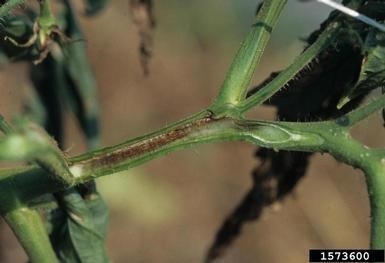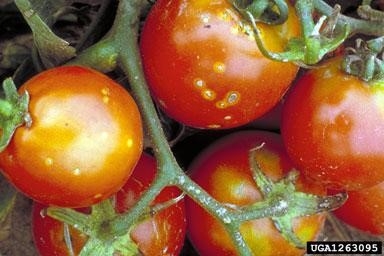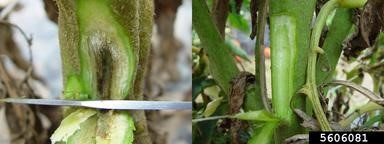General Information
First recorded in Michigan, hence the pathogen name Clavibacter michiganensis, commonly known as bacterial canker, is considered one of the most necessary-to-manage diseases in the greenhouse tomato industry. Bacterial canker spreads quickly to infect both transplanted and directly seeded crops, especially through pruning practices when shears are not properly disinfected. An epidemic can begin with a single infected seed, so disease prevention should always remain a top priority for all growers.
Pathogen
Clavibacter michiganensis is an aerobic, non-motile, non-spore forming, non-acid-fast, unencapsulated, gram-positive bacteria. Grown on nutrient agar, colonies can grow to 2-3 mm in diameter in five days at 77° F and have a yellowish appearance. Strains of this bacterial canker pathogen were formerly considered as Clavibacter michiganensis subsp. michiganensis, but now C. michiganensis is restricted to tomato and other Solanaceous crops. Additional subspecies are now considered distinct species.
Host Plants
Tomato is the primary host of C. michiganensis, but other members of the Solanaceae family (pepper, eggplant, potato, tobacco) may also be hosts.
Favorable Environmental Conditions
Bacterial canker is encouraged by warm temperatures (>75ºF) and high moisture or humidity.
Symptoms and Signs
Initially, symptoms of bacterial canker on leaves appear on the leaflet margins where they become yellow and necrotic and appear as though they have been burned on the edges. When wet, lesions may appear water-soaked on the underside of the leaves. Young plants grown in the greenhouse sometimes show light green lesions on leaflets or may show dark and sunken leaf veins. The bacterium can become systemic (occurring throughout the plant) and this results in wilting of the plant. Stems and pith can develop streaks of discoloration and the pith becomes mealy. Lesions on fruit will be raised, dark-colored spots with a light yellow or cream-colored halo.
Disease Cycle and Epidemiology
Clavibacter michiganensisis capable of survival up to two years in infected plant debris, seeds, weed hosts, and volunteer tomatoes. In addition, the pathogen can survive on contaminated wooden stakes and tools. Secondary spread (spread from the source of origin in the field or greenhouse) occurs through water spray, contamination of equipment, and roots of infected plants (mostly in hydroponic culture). Fruit spotting and foliar symptoms are common in the field from secondary spread. Secondary spread can occur in greenhouse and field environments through handling and wounding plants while transplanting, clipping or pruning, and grafting. Infected transplants may have symptoms of severe wilt and may eventually die.
General Disease Control
Clean seeds and transplants are vital to managing the pathogen both in homes and in commercial production.
- Purchase seeds that are certified free of pathogens, including C. michiganensis (seeds purchased from reputable sources tend to be tested prior to sale, but look for confirmation or contact the seller)
- Seed may be treated with dilute solutions of sodium hypochlorite or via a hot water treatment
Sanitation practices minimize the spread of the pathogen, such as the following:
- Wash re-used pots and trays to remove crop debris, then sanitize
- Use new potting media and be sure it is stored in a sanitary environment
- Dispose of wooden stakes from an infested field
- Wash hands, exposed clothing and boots regularly
- Eliminate or reduce weeds and volunteer plants
- Immediately remove and destroy all diseased material, especially in a greenhouse
Conventional, field production ought to include:
- Crop rotation to a non-host crop for 3-4 years
- Plow diseased fields with residual debris to encourage degradation
Greenhouse operations require additional attention and strict sanitation throughout the production cycle, such as:
- designate specific boots and clothes for each greenhouse or bay
- consistently wash hands before and after moving into separate greenhouses
- disinfect tools
- use filtered and/or treated irrigation water
Disease Control for Homeowners
Homeowners are suggested to follow guidelines for bacterial canker control listed above.
Disease Management for Conventional Growers
Regular, preventative spraying of copper compounds has been shown to provide some protection from bacterial canker. There are no other products that have consistently shown to control bacterial canker on tomato.
Additional Resources
The NC State University Extension Plant Pathology Portal provides a variety of disease management resources such as fungicide guides, seed recalls, diagnostic videos, etc.
The NC State University Plant Disease and Insect Clinic provides diagnostics and control recommendations.
The 2023 North Carolina Agricultural Chemicals Manual details important information related to the use of chemicals as treatments for plant pathogens.
References
Jones et al. 2016. Compendium of Tomato Diseases and Pests, Second Edition.
IPM Images "pith necrosis of tomato"
Schuh et al. 2022. Bacterial Canker of Tomato. University of Minnesota Extension.
Publication date: Jan. 9, 2024
Recommendations for the use of agricultural chemicals are included in this publication as a convenience to the reader. The use of brand names and any mention or listing of commercial products or services in this publication does not imply endorsement by NC State University or N.C. A&T State University nor discrimination against similar products or services not mentioned. Individuals who use agricultural chemicals are responsible for ensuring that the intended use complies with current regulations and conforms to the product label. Be sure to obtain current information about usage regulations and examine a current product label before applying any chemical. For assistance, contact your local N.C. Cooperative Extension county center.
N.C. Cooperative Extension prohibits discrimination and harassment regardless of age, color, disability, family and marital status, gender identity, national origin, political beliefs, race, religion, sex (including pregnancy), sexual orientation and veteran status.





